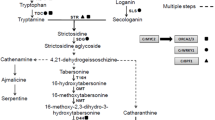Abstract
Accompanying the CAM induction of Mesembryanthemum crystallinum L. grown in high salinity there are changes in the enzymes of carbon metabolism. However, there are no changes in the electron transport activities, Chla/b ratios or in the distribution of chlorophyll amongst the various pigment-protein complexes of isolated thylakoids. Hence with CAM induction there are no changes in the photochemical apparatus of M. crystallinum thylakoids.
Despite comparable amounts of chlorophylla/b-proteins of photosystem II to those found in typical C3 sun plants, both the C3 and CAM M. crystallinum chloroplasts have relatively more photosystem II, and, concommitantly, less photosystem I complex. This is consistent with greater fluorescence emission at 685 and 695 nm, and lower emission at 735 nm (measured at 77 K) than typically found for C3 plants, whether sun or shade species.
Photoinhibition of isolated C3 and CAM thylakoids by white light led to comparable decreases in electron transport capacities and fluorescence emission at 77 K with photosystem II being more affected than PSI. We suggest however, that the presence of more core PSII complexes relative to PSI complexes in this CAM-inducible plant, may provide an additional strategy to mitigate photoinhibition in the short-term.
Similar content being viewed by others
Abbreviations
- Chl:
-
chlorophyll
- CAM:
-
crassulacean acid metabolism
- DCPIP:
-
dichlorophenolindophenol
- DCMU:
-
3-(3′, 4′-dichlorophenyl)-1,1-dimethylurea
- DPC:
-
diphenylcarbazide
- MV:
-
methyl viologen
- PS:
-
photosystem
References
Adams WW (1988) Photosynthetic acelimation and photoinhibition of terrestrial and epiphytic CAM tissues growing in full sunlight and deep shade. Aust J Plant Physiol 15: in press
Adams WW & Osmond (1988) Internal CO2 supply during photosynthesis of sun and shade grown CAM plants in relation to photoinhibition. Plant Physiol 86: 117–123
Adams WW, Osmond CB & Sharkey TO (1987a) Responses of two CAM species to different irradiances during growth and susceptibility to photoinhibition by high light Plant Physiol 83: 213–218
Adams WW, Smith SD & Osmond CB (1987b) Photoinhibition of the CAM succulentOpuntia basilaris growing in Death Valley: evidence from 77K fluorescence and quantum yield. Oecologia 71: 221–228
Anderson JM (1980) P700 content and polypeptide profile of chlorophyll-protein complexes of spinach and barley thylakoids. Biochim Biophys Acta 591: 113–126
Anderson JM (1986) Photoregulation of the composition, function and structure of thylakoid membranes. Ann Rev Plant Physiol 37: 93–136
Anderson JM, Chow WS & Goodchild DJ (1988) Thylakoid membrane organization in sun/shade acelimation. Aust J Plant Physiol (1988) 15: 11–25
Arnon PI (1949) Copper enzymes in isolated chloroplasts. Polyphenoloxidase inBeta vulgaris. Plant Physiol 24: 1–15
Barenyl B & Krause GH (1985) Inhibition of photosynthetic reactions by light. Planta 163: 218–226
Briantais JM, Vernotte C, Krause GH & Weiss E (1986) Chlorophyll a fluorescence of higher plants: chloroplasts and leaves. In: Govindjee, Amesz J & Fork DC (eds) Light emission by plants and bacteria, pp 539–583. New York: Academic Press
Chow WS, Qian L, Anderson JM & Goodchild DJ (1988) Photosynthetic acclimation ofAlocasia macrorrhiza (L.) G Don to growth irradiance: structure, function and composition of chloroplasts. Aust J Plant Physiol 15: in press
Chu ZX & Anderson JM (1984) Modulation of the light-harvesting assemblies in chloroplasts of a shade plant,Alocasia macrorrhiza. Photobiochem Photobiophys 8: 1–10
Cleland RE & Critchley C (1985) Studies on the mechanism of photoinhibition in higher plants. II. Inactivation by high light of photosystem II reaction centre function in isolated spinach thylakoids and O2 evolving particles. Photobiochem Photobiol 10: 83–92
Cleland RE & Melis A (1987) Probing the events of photoinhibition by altering electron-transport activity and light-harvesting capacity in chloroplast thylakoids. Plant Cell Envir. 10: 745–752
Demmig B & Winter K (1983) Photosynthetic characteristics of chloroplasts isolated fromMesembryanthemum crystallinum L., a halophilic plant capable of Crassulacean acid metabolism. Planta 159: 66–76
Edwards JE, Foster JG & Winter K (1982) Activity and intracellular compartmentation of inzymes of carbon metabolism in CAM plants. In: Ting IP & Gibbs M (eds), Crassulacean acid metabolism, pp. 92–111. Rockville MD. American Society of Plant Physiologists.
Holtum JAM & Winter K (1982) Activity of enzymes of carbon metabolism during the induction of Crassulacean acid metabolism inMesembryanthemum crystallinum. Planta 155: 8–16
Krause GH, BHriantais JM & Vernotte C (1983) Characterization of chlorophyll fluorescence quenching in chloroplasts by fluorescence spectroscopy at 77 K. Biochim Biophys Acta 723: 169–175
Osmond CB (1982) Carbon cycling and stability of the photosynthetic apparatus in CAM. In: Ting IP & Gibbs M (eds), Crassulacean acid metabolism, pp 112–127. Rockville MD: American Society of Plant Physiologists
Osmond CB, Winter K & Powles SB (1980) Adaptive significance of carbon dioxide cycling during photosynthesis in water-stressed plants. Turner NC & Kramer PJ (eds) In: Adaptation of plants to water and high temperature stresses pp 139–154 New York: John Wiley and Sons
Powles SB (1984) photoinhibition of photosynthesis induced by visible light. Ann Rev Plant Physiol 35: 15–44
Winter K (1985) Crassulacean acid metabolism. In: Barber J & Baker NR (eds) Photosynthetic mechanisms and the environment, pp. 329–387 Amsterdam: Elsevier
Winter K & Von Willert DJ (1972) NaCl-induzierter Crassulaceen säurestoffwechsel beiMesembryanthemum crystallinum. Z Pflanzenphysiol 67: 166–170
Author information
Authors and Affiliations
Rights and permissions
About this article
Cite this article
Köster, S., Anderson, J.M. The photosynthetic apparatus of C3 and CAM-induced Mesembryanthemum crystallinum L.. Acta Appl Math 19, 251–264 (1988). https://doi.org/10.1007/BF00046877
Received:
Accepted:
Issue Date:
DOI: https://doi.org/10.1007/BF00046877




